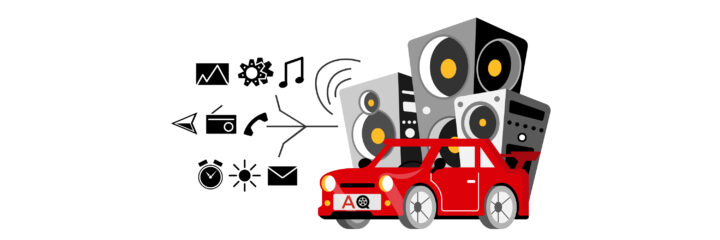Car audio systems came to the scene shortly after the arrival of cars, when drivers quickly realized that the open road was a lot more enjoyable when set to a soundtrack. While these early systems could pick up AM radio signals and play some scratchy tunes, they were also bulky, impractical, and had an annoying habit of bursting into flames.
Today, you can enjoy the radio, your own music, use GPS, make phone calls, and more – all without catching on fire! The more features they add, the harder they are to shop for.
In this guide, we’ll break down the key components of a car audio system and what features those components should have. Then, we’ll talk about the best car audio systems for 2024 and give you some pointers on choosing the right one and installing your new system.
- Picking the Best Car Audio System
- Top 9 Best Car Audio Systems 2024
- 1. Best Overall Pick: PLZ MP 800 Car Entertainment Multimedia System
- 2. Best Premium Pick: BOSS Audio Systems Car DVD Player
- 3. Best Sound Quality: Boss 820BRGB Multimedia Car Stereo
- 4. Best Budget Pick: Boss 612UA Multimedia Car Stereo
- 5. Best High Wattage System: Boss Double Din Car DVD Player
- 6. Best Bluetooth-Enabled Audio System: Pioneer Single Din Car Stereo
- 7. Most Customizable Features: Ankeway Android Car Stereo
- 8. Best Backup Camera: Minye Double Din Car Stereo
- 9. Best for Satellite Radio: SiriusXM Onyx Plus Satellite Radio With Vehicle Kit
- Car Audio System Buyers Guide
- Final Word
Picking the Best Car Audio System
The most important features to consider in your next car audio system are size, audio source, and sound controls. You’ll also want to think about what kind of extra features you might like to have beyond its ability to play crisp, clear audio.
Single vs. Double DIN
DIN is a German acronym that stands for Deutsches Institut für Normung. It refers to the standard size of car audio systems, which was set by—you guessed it—the Deutsches Institut für Normung. It’s a whole institute dedicated solely to standardizing sizes and design elements in various products, including car audio systems.
So “DIN” refers to the height, width, and length of the receiver. Thanks to the Germans and their love of standardizing things, you don’t have to go outside and measure the dimensions of your center console or look for highly customized stereo systems meant specifically for the make and model you own.
Single DIN receivers are the narrower two-inch tall systems like the Boss 6128a. Double DIN receivers are the wider four-inch-tall systems like PLZ MP 800.
In terms of receiver quality and ability to adjust sound, they’re about the same. However, a double DIN is more likely to have a touchscreen, GPS, rear camera compatibility, and all those other fancy features because there’s simply more room for a large enough display screen to have them.
Audio Source
Receivers can play audio from a variety of sources. At a bare minimum, they’ll usually have an AM/FM receiver so that you can listen to the radio. Most modern designs also have an AUX port so that you can plug in your phone.
Other sources you might want include Bluetooth, USB, or even preinstalled music streaming apps on the receiver itself.
Sound Controls
For audiophiles, this is one of the biggest deciding factors. How much control does your receiver give you to tweak the sound settings to perfectly match the music you’re listening to?
Some of the newer receivers that pack a ton of extra features might skip these fundamental sound controls in favor of automating those settings for convenience. So newer and fancier isn’t always better for those who are on a quest for the perfect sound.
In your case, you’ll want advanced sound controls like bass and treble adjusters, time correction, and even a parametric equalizer. You might also want the ability to create sound presets to quickly switch between different settings depending on what you’re listening to.
For example, something like the Boss Multimedia car stereo might look basic compared to the touchscreen models, but it comes with bass, treble, balance, and fader controls as well as preset equalizer settings.
Preamp Outputs
The receiver itself won’t have enough output current to connect directly to your speakers, so you’ll need to buy an amplifier to actually boost the sound enough to come out of your speakers until it is loud enough for you.
However, before shopping for an amp, you need to check the preamp outputs on your audio system. These are the jacks on the back of the receiver where your amp would connect.
For those looking to build the ultimate sound system, you need multiple preamp outputs, ideally around three. This allows you to connect front speakers, an amp, and a subwoofer (or a second amp).
For those with more modest sound system plans, a single or double output will be plenty.
Power
The wattage on your system will determine how big you can go before it’s time to buy an amp. This power is usually given as a wattage value multiplied by four.
For example, you might see a system that advertises, “60 watts x 4 max power.”
This means that the system can deliver up to 60 watts to each speaker, up to four speakers. If you have more speakers than that, or you have a subwoofer or anything else that requires more power, you need an amp.
For a basic 4-speaker sound system, the receiver you get should have a minimum of 50 watts per speaker. Any lower than this, and you’ll need to look at either adding an amp or getting high sensitivity speakers.
Now that you have a better idea of what the audio system is and what kind of features you can expect to see, browse through our favorite car audio systems for 2024:
| Product | Double DIN | Power | Source | Sound Controls | Rating |
|---|---|---|---|---|---|
| PLZ MP 800 Car Entertainment Multimedia System | 60 Watts x 4 Max Power | AM/FM, AUX, USB, Bluetooth, Mirror Link | Bass, Treble, Fader, Balance, ten customizable preset EQ options | 5 | |
| BOSS Audio Systems Car DVD Player | 80 Watts x 4 Max Power | AM/FM, AUX, USB, SD, Bluetooth, CD/DVD player | Bass, Fader, Treble, Balance Controls | 5 | |
| Boss 820BRGB Multimedia Car Stereo | 60 Watts x 4 Max Power | AM/FM, AUX, USB, Bluetooth, CD Player | Bass, Treble, Fade, Balance, four customizable preset EQ options | 4.5 | |
| Boss 612UA Multimedia Car Stereo | 50 Watts x 4 Max Power | AM/FM, AUX, USB | Bass, Treble, Balance, Fader | 4.5 | |
| Boss Double Din Car DVD Player | 80 Watts x 4 Max Power | AM/FM, AUX, USB, Bluetooth, CD/DVD Player | Fader, Bass, Treble, three Preset EQ Options | 4.5 | |
| Pioneer Single Din Car Stereo | 50 Watts x 4 Max Power | AM/FM, AUX, USB, Bluetooth | Bass, Treble, Balance, Fader, Preset EQ Options | 4 | |
| Ankeway Android Car Stereo | 60 Watts x 4 Max Power | AM/FM, USB, SD, Bluetooth, CD/DVD Player, Mirror Link | Bass, Treble, Balance, Fader, Preset EQ Options | 4 | |
| Minye Double Din Car Stereo | 60 Watts x 4 Max Power | AM/FM, AUX, USB, Bluetooth | Bass, Treble, Balance, Fader | 4 | |
| SiriusXM Onyx Plus Satellite Radio With Vehicle Kit | N/A | SIRIUSXM | None | 3.5 |
Top 9 Best Car Audio Systems 2024
1. Best Overall Pick: PLZ MP 800 Car Entertainment Multimedia System

Editor’s Rating:
Quick Facts
- Double DIN
- Power: 60 Watts x 4 Max Power
- Source: AM/FM, AUX, USB, Bluetooth, Mirror Link
- Sound Controls: Bass, Treble, Fader, Balance, ten customizable preset EQ options
The responsive touchscreen, the adjustable rear or front view camera, and the wide variety of sound controls make this a great system for the driver who wants it all but doesn’t want to blow their whole sound system budget on the receiver alone.
Audio
While a lot of touchscreen audio systems tend to leave out sound controls in favor of loading up the system with a ton of cool extra features, that’s not the case here. The user interface includes a touch-navigable equalizer screen.
This equalizer comes with ten preset settings for different genres, as well as the opportunity to create and save your own preset. Moreover, you can adjust the levels on those presets if you want to tweak the default.
This system has three preamp outputs, allowing you to expand with up to two amps and one subwoofer—or one amp and two subwoofers if you’re all about that bass.
Extra Features
Extra features include a full range of input options from the standard AUX port to a strong Bluetooth signal. The most impressive extra feature, however, is the camera that comes with the system.
This can be mounted on either the front or the back of your car. Unlike other systems that come with cameras, this one is mounted on a set of hinges so it can be adjusted up and down, giving you a wider field of view.
While the touchscreen can be turned off when still listening to music, the control buttons along the side remain lit no matter what. This won’t be too big of a problem during the day. However, people who drive mostly at night might find this annoying.
For something with less distracting lights, try the Boss 6128a, which has a dimmer display.
Pros
- Three preamp outputs
- Precision sound controls and full EQ customizability
- Responsive touchscreen
- Adjustable rear or front view camera included
Cons
- No dimming option for the brightly lit control buttons
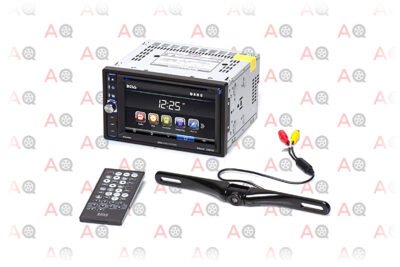
Editor’s Rating:
Quick Facts:
- Double DIN
- Power: 80 Watts x 4 Max Power
- Source: AM/FM, AUX, USB, SD, Bluetooth, CD/DVD player
- Sound Controls: Bass, Fader, Treble, Balance Controls
This is one of our favorite audio systems on the market, thanks to the high-definition display, quality construction, and versatility. No matter what your top priorities are for your new sound system, this receiver has something for everyone.
Audio
In addition to the standard AM/FM receiver and AUX port, you can also play music via USB, Bluetooth, and CDs! Even when you’re driving through a dead zone, you’ll still have access to your tunes.
For those who want to build a next-level sound system, the three preamp outputs give you the flexibility you need to go as big as you want to.
However, at 80 watts, this system is powerful enough to handle up to four speakers, all on its own without an amp. So, for the more budget-conscious, you can splurge on this premium receiver and then save money on an amp if you’re not as concerned about achieving audio perfection in your car.
Extra Features
The CD/DVD player is one of the more impressive add-ons in this system, but the camera that’s included is also noteworthy. The camera’s design is really modern. It sits flat across the top of your license plate and the camera portion itself can rotate to give you a wide view range.
However, if you don’t need the rearview camera, you can save a few bucks and get the system without the camera here.
The biggest drawback of this device is the Bluetooth microphone. If you’re making a call via your stereo, you’ll need to speak on the louder side in order for the mic to pick up your voice. For those who rarely make calls via your car audio system, this probably won’t ever be an issue.
However, if you do handle a lot of phone calls while driving, this could quickly get annoying.
For those who need a better Bluetooth mic, check out the Minye.
Pros
- High wattage system can handle up to four speakers without an amp
- Three preamp outputs
- CD player included
- Rotating rearview camera design
Cons
- The bluetooth mic doesn’t pick up voice well
3. Best Sound Quality: Boss 820BRGB Multimedia Car Stereo
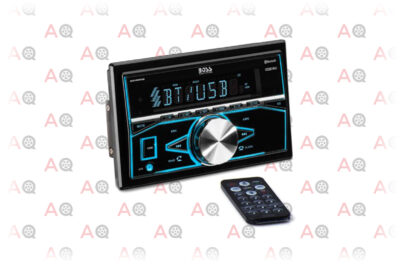
Editor’s Rating:
Quick Facts
- Double DIN
- Power: 60 Watts x 4 Max Power
- Source: AM/FM, AUX, USB, Bluetooth, CD Player
- Sound Controls: Bass, Treble, Fade, Balance, four customizable preset EQ options
If you don’t have any interest in a touchscreen display but still want the quality and power that a double-DIN system can offer, this 60-watt system with advanced Bluetooth capabilities is a great pick. It offers similar power and reliability but at a much lower price!
Audio
The 60-watt system can handle up to four speakers, provided you’re not looking for an advanced, crystal clear sound system. If your goal is something that sounds decent, lasts a long time, and fits a tight budget, this is definitely the way to go.
For those who do want something more advanced but would like to invest most of their sound system budget in great speakers, amps, or subwoofers, this is also the way to go.
There are two preamp outputs, which will be enough for both an amp and a subwoofer.
It also offers a good range of sound controls, including four EQ presets that you can customize and save.
Extra Features
This system boasts one of the strongest and most reliable Bluetooth connections so it’s an ideal pick if that’s one of your top priorities.
It also comes with a CD player and a USB port. However, beyond that, there are not too many extra features. It’s a more minimalist design intended for drivers who don’t want a ton of features crowding up their dash.
One nagging inconvenience is the fact that you can’t set the display to show the clock constantly. When it’s on, you can push “clock” to show the time, but it will default back to the previous screen after a short time.
When it’s off, the display shows nothing. This will probably be most annoying during a morning commute or on the way to an appointment. If that’s too much of an inconvenience, check out the Ankeway, which displays the clock at all times.
Pros
- 60-watt system can handle up to 4 speakers on its own
- Two preamp outputs
- Strong Bluetooth connection
- Quality, lasting design
Cons
- Clock doesn’t stay on display
4. Best Budget Pick: Boss 612UA Multimedia Car Stereo
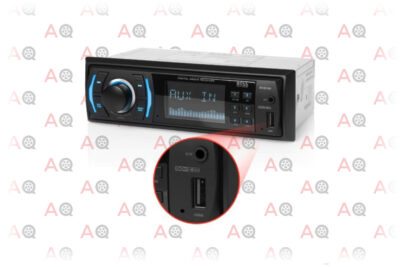
Editor’s Rating:
Quick Facts
- Single DIN
- Power: 50 Watts x 4 Max Power
- Source: AM/FM, AUX, USB
- Sound Controls: Bass, Treble, Balance, Fader
BOSS is a great option when you’re looking for something that’s built well enough to last for years but still affordable enough to allow you to splurge where it really counts. This basic, no-frills receiver does almost everything a music-lover could need without cluttering up your dash with unnecessary extras.
Audio
While you will need an amp to go with this system if you want crystal clear audio, there are two preamp outputs, which give you room for the amp as well as a subwoofer.
Since serious audiophiles are usually buying these additional components anyway, this is the best way to go if you just want something that allows you to put most of your budget into buying top tier speakers and a solid amp and subwoofer set up, this is it.
You can’t save any EQ presets with your preferred sound settings, so you’ll have to tweak this each time you put on music if you’re looking for the perfect sound. If you’d like the convenience of saving your own customized presets, check out the PLZ MP 800 instead.
Extra Features
There’s not a lot of extra features to speak of. This is really your bare-bones car audio system for those who just need something to tie their whole sound system together. The features it does have work well, but it won’t impress anyone who’s looking for additional functionality beyond playing music.
There may not be any bells and whistles, but when you’re listening to your favorite road trip playlist in perfect high-definition surround sound, you won’t miss them.
Pros
- Great budget option
- Reliable, long-lasting design
- Two preamp outputs
Cons
- Can’t save customized EQ presets
- No advanced features or connectivity
5. Best High Wattage System: Boss Double Din Car DVD Player

Editor’s Rating:
Quick Facts
- Double DIN
- Power: 80 Watts x 4 Max Power
- Source: AM/FM, AUX, USB, Bluetooth, CD/DVD Player
- Sound Controls: Fader, Bass, Treble, three Preset EQ Options
This high-powered double DIN system has plenty of source options, outputs, and sound controls to turn into a great, fully customized sound system, no matter what your budget is. It works well as a standalone system but leaves you with plenty of room to grow.
Audio
The 80-watt system is strong enough that you can postpone getting an amp or subwoofer if you need to. This will perform well on its own. However, when you are ready to expand your system, you’ve got three preamp outputs available, so you can go as big as you want to.
With customizable preset options and all the essential sound controls, you can precision adjust the output to match your music.
The volume knob can be a little tricky. If you turn it too fast, it doesn’t respond as rapidly. Once you get in the habit of rotating the knob slowly, this won’t be a big deal.
Extra Features
This has a good Bluetooth connection and a wide range of source options. It’s also compatible with your steering wheel controls, although it can be tricky to actually set that feature up.
The touchscreen can be a little slow to respond. Like the volume knob, you will eventually get used to the response time on the screen. However, when you first get it, it can be frustrating trying to navigate the screen.
For something with more responsive controls, check out this Boss touchscreen system.
If you’re planning on installing this yourself, it could get tricky if you don’t have any experience installing car audio systems. The instructions that come with the system are vague and not as helpful as they could be.
Pros
- Powerful 80-watt system
- Three preamp outputs
- Wide range of source options
- Includes CD player
Cons
- Minimal installation instructions
- Volume knob and touchscreen are less responsive
6. Best Bluetooth-Enabled Audio System: Pioneer Single Din Car Stereo

Editor’s Rating:
Quick Facts
- Single DIN
- Power: 50 Watts x 4 Max Power
- Source: AM/FM, AUX, USB, Bluetooth
- Sound Controls: Bass, Treble, Balance, Fader, Preset EQ Options
This single DIN car stereo may not be much to look at, but it’s a high performer. With a solid Bluetooth connection and the option to pair up to two devices at the same time, this is a great system for professionals who like to do business from the car.
Audio
With two preamp outputs, incredible connectivity, and a full range of sound controls, this is a great foundation for building a solid sound system. At only 50 watts, you’ll definitely want an amp. However, a solid sound system usually has more than four speakers, so you’d need an amp no matter which receiver you get.
We love the sensitivity of the volume knob. You can adjust up and down rapidly and it’s very responsive. However, one issue here is that it doubles as the settings knob. By pressing in on it, you change it to settings.
While that is an economical design, it also means that it’s easy to accidentally change it to settings if you’re not paying attention. You’ll have to look to get it back out of settings without accidentally changing any settings, which isn’t safe to do while driving.
There is a small remote that comes with this system where the volume and settings controls are separate. We recommend keeping that in arms reach while driving and adjusting volume that way instead.
Extra Features
The Bluetooth connection on this system is great. Once your device is paired, the stereo can find it immediately and the connection is strong and steady.
What’s most impressive, however, is that it offers dual connections. So, you can pair two phones to it at the same time. This is really useful for anyone who has a work and personal phone and wants to be able to answer calls on either one while driving.
However, navigating the connected device isn’t that user-friendly. Basic functions like skipping a song or adjusting the volume are fine. However, answering a call, switching to a different playlist, and other functions will still need to be done from your phone.
For something with better built-in Bluetooth controls, check out the Minye.
Beyond its impressive Bluetooth capabilities, it also boasts a dedicated Spotify audio source. When you play from your Spotify app on your iOS or Android device, you can fully navigate and control the app from your audio system. Skip tracks, browse playlists, select albums or stations all from your dash!
Pros
- Advanced Bluetooth connection
- Dual Bluetooth allows you to pair up to two devices
- Dedicate Spotify audio source
- Two preamp outputs
Cons
- Lack of Bluetooth controls
- Issues with volume knob
7. Most Customizable Features: Ankeway Android Car Stereo
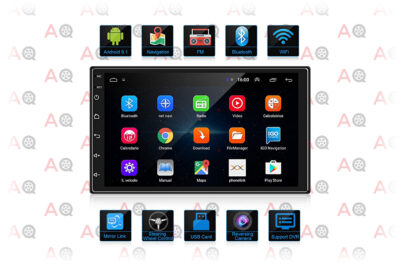
Editor’s Rating:
Quick Facts
- Double DIN
- Power: 60 Watts x 4 Max Power
- Source: AM/FM, USB, SD, Bluetooth, CD/DVD Player, Mirror Link
- Sound Controls: Bass, Treble, Balance, Fader, Preset EQ Options
For those who want to turn their dash into a totally personalized driving assistant, this Ankeway audio system is the one to get. The touchscreen display comes with an Android operating system, essentially transforming it into a tiny computer that also remembers your favorite radio stations.
Audio
As the receiver in your sound system, this Ankeway offers a good range of source options and three preamp outputs, which gives you a lot of room for expansion.
One drawback is that you can’t save the adjustments you make to any of the preset EQ options. They immediately reset to their default settings when you turn it off and on again. This means you’ll have to tweak the sound controls each time you turn on the car if you have particular sound preferences.
If you plan to be creating your own customized EQ settings, you’d probably prefer something like the PLZ MP 800 that allows you to lock in your own preferences.
Extra Features
The extra features are what really stand out on this system. In addition to Bluetooth, Mirror Link, and compatibility with steering wheel controls, this system allows for complete customization.
Any app that can work on an Android device will work on this system. You can navigate with Google Maps, browse the internet, listen to your favorite YouTubers, all without having to rely on your phone.
The instructions for installation are unclear and unhelpful. If you don’t have experience installing audio systems, we recommend looking for a tutorial online or paying for professional installation.
Pros
- Android OS allows you to download any feature you want
- Three preamp outputs
- Compatible with steering wheel controls
Cons
- Can’t save your own EQ settings
- Unhelpful installation instructions
8. Best Backup Camera: Minye Double Din Car Stereo
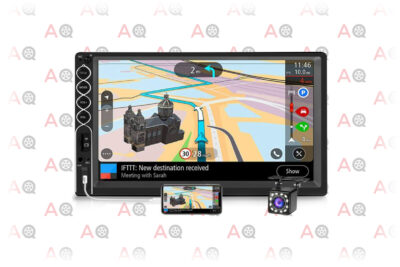
Editor’s Rating:
Quick Facts
- Double DIN
- Power: 60 Watts x 4 Max Power
- Source: AM/FM, AUX, USB, Bluetooth
- Sound Controls: Bass, Treble, Balance, Fader
There’s a lot of good features here that make it an affordable yet versatile audio system with a wide range of functionalities. It’s got a stable Bluetooth connection, a rearview camera, and lots more that drivers will appreciate.
Audio
As far as sound is concerned, this is not especially impressive. The 60-Watt system is strong enough for reasonable sound quality in up to four speakers.
However, anyone looking to add more than four speakers will be out of luck as this has zero preamp outputs. This means you can’t add an amp or subwoofer.
If you’re getting this system mostly for the helpful features, this is a good choice. But if you’re looking to build a good sound system to listen to your music in crystal clear perfection, this won’t have what you need.
In that case, you’d do better with the Boss double DIN.
Extra Features
While this does offer Mirror Link, the feature is a little glitchy, especially with iPhones. Sometimes it will display the screen but not play sound. Sometimes it will disconnect randomly. It just generally doesn’t work very well.
However, all the other features do work well, so if you have little use for mirror linking, you won’t miss it. That includes the included rearview camera and the dual Bluetooth 4.0 connection that allows you to keep two devices connected at the same time.
Pros
- Dual Bluetooth connection
- Rearview camera included
- Strong, stable Bluetooth connection
- High resolution display
Cons
- No preamp outputs
- Mirror link feature is glitchy
9. Best for Satellite Radio: SiriusXM Onyx Plus Satellite Radio With Vehicle Kit
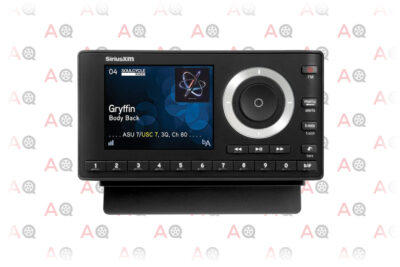
Editor’s Rating:
Quick Facts
- Double DIN
- Power: N/A
- Source: SIRIUSXM
- Sound Controls: None
With a clear display and user-friendly controls, this is a great way to listen to your favorite stations and your favorite music on the road, even when you’re out of range of AM/FM signal towers.
Audio
It’s important to note that this is not a standalone audio system. It’s an add-on specifically for SiriusXM. You’ll want to invest in a basic system like the Boss Multimedia Car Stereo to get your standard AM/FM connection.
With that said, it couldn’t be easier to install. It connects to the rest of your system using the AUX input.
This means you can also take it with you and plug it into your home speaker system or move it from one car to another with ease. This kind of versatility and portability helps make up for its limited functionality.
There are no sound controls on this system so audiophiles will not have that customizability they need to tweak the bass, treble, or balance. If you want adjustability, the Boss 6128a offers those sound controls at a similar price point.
Extra Features
If you have or want a SiriusXM subscription, this is an affordable and functional system to choose. If not, you’ll likely be disappointed in the lack of source options. It has no AUX, USB, or Bluetooth, so your only option is to listen to SiriusXM radio.
Pros
- Portable
- Easy to install
- User-friendly display
Cons
- Paid subscription required
- Lack of versatility
Car Audio System Buyers Guide
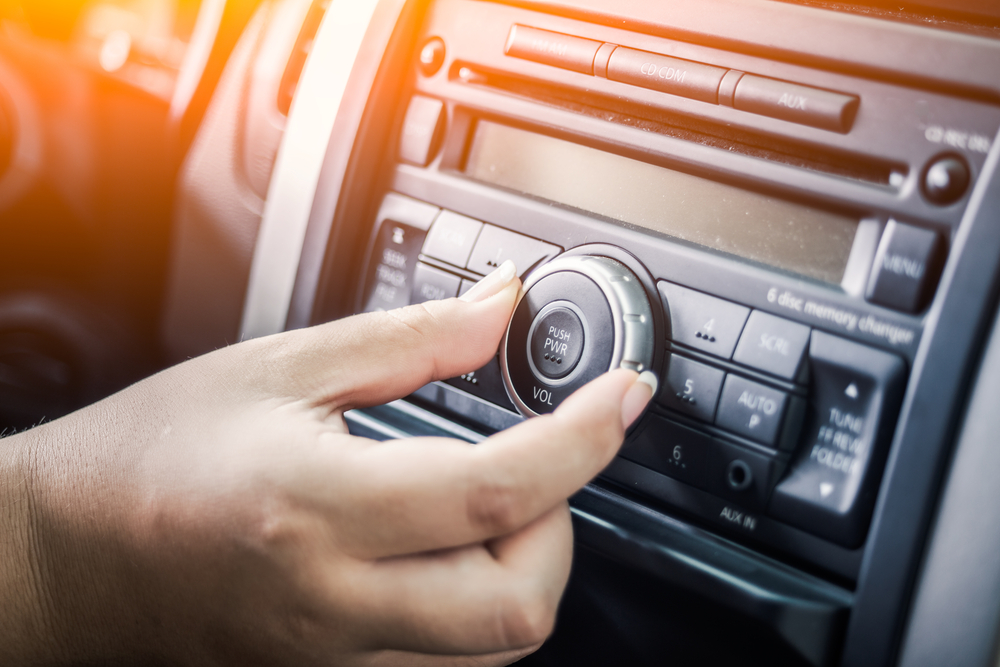
Digging through all the specs and features of audio systems can get overwhelming, so we’ve put together some helpful answers to some of your most pressing questions. This should give you a better idea of what to expect and what to look for:
When Should I Replace My Car Audio System?
If you’ve still got the factory system installed, you should probably do it now. While factory audio systems have improved since the days of Paul Galvin and his flammable radio, they still rarely hold up to even a modest aftermarket system.
Moreover, replacing the system yourself gives you an opportunity to customize it to your needs. Instead of paying for upgrades at the dealership, you can simply buy the parts that matter to you most without having to pay for features you don’t care about.
In the next section, we’ll go into more detail about how to balance your budget with your sound system priorities.
If your current setup is already an upgrade from the factory-installed system, the rule of thumb is to replace it every 4-6 years. This time frame allows you to get your money’s worth out of the system while still keeping your car up to date with the latest technology in terms of system features on the receiver itself and sound quality in the speakers and amp.
If you don’t really care about keeping up with the latest tech, you can also just wait to replace it when it breaks or when the sound quality has noticeably deteriorated.
Making Sure Your New Audio System Is Compatible
We talked a bit about the major factors to consider when choosing a car audio system earlier in this guide. However, as with any piece of technology, it can get a little complicated when you start trying to figure out what’s compatible with your existing speakers or amps and what kind of specific functionalities you need.
To help you answer those more technical and specific questions, we’ll go a little more in-depth on those features below:
Single and Double DIN Dash Kit
As you read earlier, DIN simply refers to the dimension of the receiver. Here’s the rub: a lot of newer models, particularly since the 2000s, are starting to design center consoles that are no longer standardized, to the dismay of most Germans.
If you have a pre-2000s car or a model with a standardized dash, count yourself blessed. You can simply choose the DIN that matches your dash and be done.
For the rest, you’ll need to spend a little extra time and money on something called a dash kit.
Double DIN dash kits or single DIN dash kits are used to retrofit your dash with the correct frame size to support your new receiver. The kits will often list which vehicles they’re meant for so you can check whether it’s compatible with your car.
GPS
GPS is a very convenient feature to have, especially for going on road trips or for people who drive for a living. While most smartphones already have GPS, the perk of having it built into your car is that you don’t have to hook up your phone and risk draining its battery when you need to navigate.
However, if this is a must-have feature for you, you’ll want to choose something with an intuitive user interface and a responsive touchscreen like the Ankeway.
Using the navigation system requires inputting addresses, scrolling across the map, and a lot of other tasks that require interacting with the screen. If that screen has a delayed response or just doesn’t work well, trying to use the on-board GPS can become more trouble than it’s worth.
Bluetooth Support
While lots of systems will advertise Bluetooth capabilities, not all systems are created equal. Some offer more solid and reliable Bluetooth connections than others. Some offer more built-in controls than others.
The Pioneer, for example, has one of the strongest Bluetooth connections of any car audio system but it lacks in some of the more advanced control features you might want. The Boss DVD Player system, on the other hand, has great control options but the connection itself isn’t as strong, particularly during phone calls.
If Bluetooth is high up on your priority list, you can’t just choose any system that advertises Bluetooth. You’ll also want to check the transmit power and receiver sensitivity to check how reliable the Bluetooth feature actually is.
CD Player
Since music has shifted more and more to digital sources like your phone or music streaming apps, it’s not a given that your new system will come with a CD player. If you want one, you have to make sure you specifically search for one that has it, like this Boss Double Din system.
Getting the Best Sound Quality in Your Car
Once you’ve got the perfect audio system, you need to combine it with an amplifier and some speakers. You may also want to consider adding a subwoofer. Let’s take a quick look at what role each of these parts plays and what factors you’ll need to consider:
Speakers
When choosing speakers, you need to think about two things: system compatibility and frequency range:
System Compatibility
The car audio system you choose will influence the type of speakers you can get. Unless the speakers are your highest priority in your set up. In that case, you’ll want to match your system to the speakers you get.
Either way, they need to be compatible in terms of their sensitivity and power handling. A car audio system delivers a certain amount of power, measured in watts.
The factory system your car came with is probably lower powered (below 15 watts) while most of the systems you find on the market are higher powered (16+ watts). This is especially true with more feature-rich designs like the Ankeway.
The lower the wattage of your system, the higher the sensitivity on the speakers needs to be. Sensitivity is measured in decibels and anything above 90 dB is considered high. If the sensitivity isn’t high enough, the audio coming out of them will sound muffled and far away.
On the other end of the spectrum, if you pair high sensitivity speakers with a high-powered audio system, you’ll end up blowing out the speakers. If you’ve got a 16+ watt system or if you’ve added an amplifier to it, look for lower sensitivity speakers.
To make this easier, just remember: the higher the wattage, the lower the decibels.
To make it even easier, many speaker manufacturers will tell you right on the label what wattage the speakers can handle. Just look for something called the RMS rating. This rating is usually given as a range, such as 10-80 watts. It refers to the power range the speakers have been designed to handle.
If your system falls within the range specified, you know they’re compatible.
Frequency Range
The speakers in your car are built to handle a specific frequency range. The broader that range is, the more complexity and clarity you’ll be able to hear in your music.
If your car were full of mid-range speakers that could only play frequencies between 200-2,000 Hz, you’d miss a lot of the depth in the bass and drum portions of the song as well as the highs that some vocalists achieve.
The result will be a kind of flattening of the song.
A good sound system should have a mix of mid-range and high speakers. This will enable your audio system to clearly play songs ranging from 200-20,000 Hz. That broad range can handle almost the full spectrum of music.
The only music it might start to fall flat on is really low frequency drum and bass. For that, you’ll want to look for a subwoofer.
Subwoofer
A subwoofer is a type of speaker that’s specifically built to play lower frequency sounds between 20-200 Hz. The reason it isn’t grouped together with the other speakers is because it needs to be substantially larger in order to handle those lower frequencies, which create a lot of vibrations.
Your system will technically work just fine without one. However, if you’re an audiophile, they’re a necessity. They add a depth and richness of tone that you can’t achieve with even the best speakers.
As mentioned earlier, the frequency range your system can handle determines how much clarity and complexity comes through in the song. If you want to hear that drum solo in all its glory or jam out to Yo-Yo Ma without missing a single reverberation of his bow, you need a subwoofer that can reproduce those rich, lower frequency tones.
However, a good subwoofer can cost about as much as the rest of your sound system combined. So, if your Yo-Yo Ma jam sessions aren’t a regular thing, it may not be worth the added expense.
If you’re unsure, skip it for now and focus on the receiver, speakers, and amplifier. Worst case scenario, you can always add a subwoofer later. They’re easy to install and they usually just sit right in your trunk so there’s less fiddling around with tiny screws.
Amplifier
Your car audio system will have a small built-in amplifier already. This will be fine enough for 2-4 speakers if they’re high sensitivity speakers. However, for a set up with anything more than that, you need an amplifier.
An amplifier is basically just a signal booster. You feed the signal from your receiver through the amplifier and then out to your speakers. The amp boosts it and divides the frequencies to send them to the appropriate speakers (such as left and right speakers or high and low range speakers).
By dividing the frequencies, you get a much cleaner sound. Instead of sending the full frequency range to every speaker, the highs go to your high range speakers and the lows go to your lower range speakers and your subwoofer if you have one.
If the full frequency range where to go to a single speaker, you’d get that tinny or grainy sound that muddies up your audio. That’s because the speaker is trying to reproduce a frequency it’s not meant to handle.
Amps are easy to install because your audio system will usually have at least one hookup on the back to add an amp. So, it’s really just a matter of plugging in and going.
When shopping for an amplifier, you need to check the RMS rating, just as you do for your speakers. However, where a speaker’s RMS rating tells you how much power can feed into it, an amp’s rating tells you how much power comes out of it.
Make sure the speakers and the amp have matching RMS ratings. You should also make sure that the casing on your amp is heat proof. Amps are powerful and generate a lot of heat when they’re on. So, a heat proof casing prevents it from overheating.
How Many Speakers Should I Put in My Car?
Most audio systems are built to handle at least four, though sound quality varies depending on the wattage. Some cars can fit as many 20+ speakers if you’ve got the amp power to support it. If you don’t want to overthink it, just stick to getting however many speakers you need to replace the ones already in your car.
If you do want to modify your system to have a different number than what the car came with, the number you end up choosing will depend on what you’re trying to achieve. Here are a few guidelines that can help you land on the right number for your needs:
- 2-4 speakers: this is enough if listening to music is low on your priority list. You don’t need perfect depth and tone for talk radio or phone calls.
- 4-8 speakers: this is a good range for most purposes as long as you get a mix of speaker types. At the higher end of the range, it’s enough to create a nice surround sound experience. At the lower end, your music will sound clear, but you might lose a bit of complexity and richness.
- 8-12 speakers: anything beyond eight speakers is only necessary if you’re trying to create the perfect 3D sound with the widest possible range of frequencies. This is the range you want to be in when you want your system to sound like your favorite band is in the car with you.
Installing additional speakers beyond the number your car originally came with should be done by a professional with in-depth experience on speaker placement. Otherwise, you’ll likely be wasting your money.
This is because one of the main reasons for a high number of speakers is to create an optimal 3D sound distribution or surround sound. You can’t do that by simply throwing a bunch of speakers into your car. It requires precise configuration based on the size and shape of the cabin.
Can I Install a Car Audio System Myself?
You absolutely can! First timers might need to spend a little more time double and triple-checking that they’re connecting the right wires to the right places, but it can be done. If you’re simply replacing the existing system, then it’s just a matter of hooking up the new system the same way the old one had been hooked up.
If you’re adding subwoofers or amplifiers, this can make it a bit more challenging but still totally doable.
If you’re feeling a little daunted at the idea of messing with dash kits and wiring, you can read this helpful step-by-step guide to installing a new car audio system, specifically written for first-time installers.
There are two cases where you might benefit from a professional installation, though. The first is when you plan on adding more speakers than your current system has. Putting additional speakers into your car requires knowledge of where exactly to place them and how to expand your system to accommodate the additional speakers.
The second case is when you have a factory audio system in your car that is just way too proprietary. It may not be compatible with the standard ports and wiring found on the more universal store-bought systems. Some car manufacturers do this intentionally so that you have to come to the dealership to do any upgrades.
Other Components to Complete Your Car Sound System
Once you’ve chosen the right receiver, finish your set up with these other parts to get a full sound system upgrade:
- Car Speakers. A great system needs great speakers to really get the full experience of everything the receiver is capable of.
- Car Amplifier. This is the part that helps pump up that electrical signal coming from the receiver and sends it to your speakers at full tilt so it’s strong enough to come through all of your speakers with equal clarity.
- Subwoofers. These help those deeper tones in your music come through with full resonance and richness so that you really feel each song.
- Sound Deadening Mats. These block out the sounds of the road while you’re driving so that you can experience your upgraded sound system without interference.
Final Word
A great car audio system has the features you need to make your drive better. For some, that might mean top of the line sound quality with precision audio controls as seen on this Boss system. For others, it might be more about having tons of helpful features and extras as found on the PLZ MP 800. Whatever your priorities, be sure to take a close look at the specs to make sure the car audio system you choose does exactly what you need it to!
